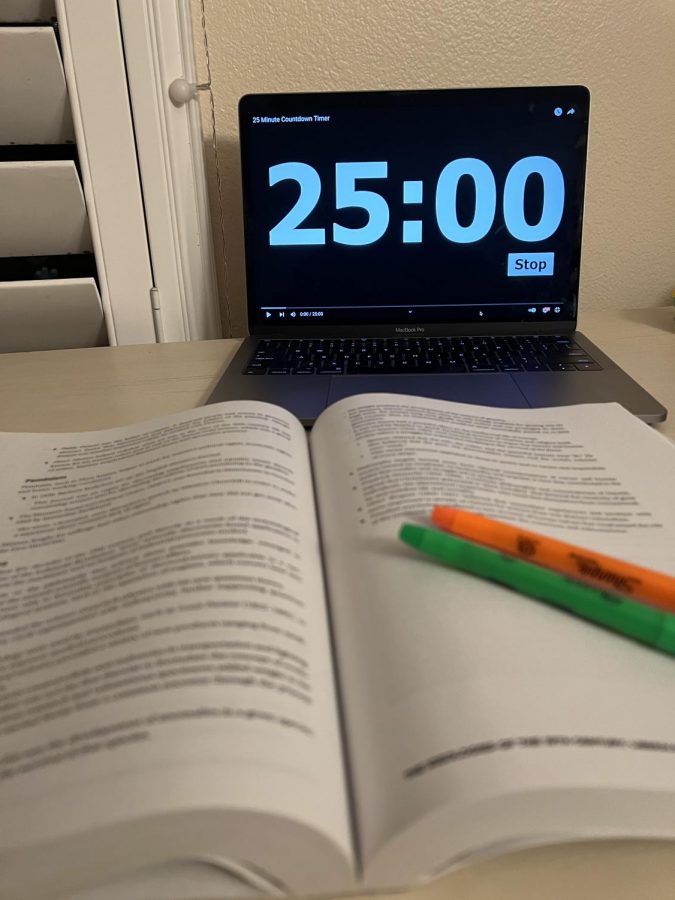Five tips to finish the fall semester strong
Studying while using the Pomodoro technique
November 27, 2021
With the end of the first semester coming to a close, studying can be very stressful. The American Psychological Association reports that “83% of the teens surveyed said school was a significant or somewhat significant source of stress.” This means that it is important to help your stress levels by incorporating studying tips to aid with upcoming tests and quizzes. Being stressed for too long can cause eating changes, irritability, mood swings, and sickness. Here are five study tips to help you get through the finals season.
- Study in 25 Minute Periods with Five Minute Breaks. This is a method called the Pomodoro Technique, and it focuses on building strength through interval training. According to a Harvard study, “Taking frequent breaks can improve mental agility and prevent burnout.” Attention spans can be short, so it’s important to work with yours, not against it. Studying for a long period of time can leave students feeling disjointed and needing to reread materials, but by exercising the mind in intervals, your brain becomes more agile.
- Create Study Guides. Teachers and textbooks will often allude in class to what will be on the test. If a book or lecture mentions a term multiple times, there is a likelihood that it will appear on the next quiz or assessment. Compare notes with friends as well, maybe they heard an important note that you did not, or vice-versa. Use this to your advantage and create study guides. Some useful ideas are to create flashcards, or relate pictures to the terms. This can help with long term memory, especially as the material stays fresh in the mind. Review materials can be seen on websites like Quizlet, Cram, and Khan Academy.
- Highlight. Highlighting important terms can help you look back at past work and find important information. While this is not an effective study tip on its own, it can be beneficial to make study guides. One suggestion is to color-code your highlights: yellow could be a main idea, green could be vocabulary, and orange could be important dates. This helps cut down time looking for important details and can also prove to be beneficial for jogging memory on tests. The influence of color has been proven by the National Center for Biotechnology Information: “Color helps us in memorizing certain information by increasing our attentional level.” Overall, using highlighters, especially color-coded ones, can help with memorization and attention to important details.
- Diffuse. Remember to diffuse while studying. When the mind is tense, it doesn’t allow for the brain to process the information. By focusing on studying, you tire your mind out and make it harder to concentrate and fully digest the information. Diffused learning goes back to the Pomodoro Technique of taking breaks to help strengthen your brain. Allowing the mind to make connections that are not forced, by simply stepping away from the information, is just as effective. Subconsciously seeing the bigger picture by letting the mind wander brings in a different perspective. Indirectly studying has greater effects than you might think.
- Review Your Notes Periodically. When you look over notes, you jog your memory from before. Doing this often means it takes less time to jog your memory during the big test. Studies done on “the forgetting curve” and in AVID show that information is quickly forgotten – roughly 65% in one hour. By rereading materials often, you can slow down the curve of forgetting. Other ways to slow down the curve could be to invite friends onto calls to talk about the material. If you can teach the material, you know the material, according to the Feyman technique. This can benefit both you and your classmates, and help you to remember the materials for longer periods of time.
Remember to stay stress free and don’t procrastinate. Good luck, and have fun studying!









![[Photo Essay] What are the Bulldogs most used apps?](https://ayalabulldogtimes.org/wp-content/uploads/2024/05/Untitled_Artwork-23-1200x882.png)








![Khalea Turningan has recently signed with the University of La Verne, to continue playing soccer after she graduates from Ayala. “Ive enjoyed [soccer] so much that I committed,” Turnigan said.](https://ayalabulldogtimes.org/wp-content/uploads/2024/02/Screenshot_20240201_122135_Instagram.jpg)










![Girls golf team at Glendora Country Club after their victory against Glendora High School. [From left] Lin Xu (9), Elisabeth lee (10), Eva Alcantara (10), Julie Zhao (9), Madison Soong (10), Priya Devine (10), Rachel Lee (9), Bella Campagna (12), Malaya Csupak (12), Julianna Limchu (12), Kailyn Dang (11), Hannah Reyes (11).](https://ayalabulldogtimes.org/wp-content/uploads/2023/11/IMG_6906-e1699247144815-1200x871.jpeg)























![[Valentines Writing Comp 24] How Dare You?](https://ayalabulldogtimes.org/wp-content/uploads/2024/03/IMG_1687-1200x794.png)
![[Valentines Writing Comp 24] Roses and Violets: A Modern Love Letter](https://ayalabulldogtimes.org/wp-content/uploads/2024/03/IMG_1686.png)





![[Episode 2] Fast fashion on the environment](https://ayalabulldogtimes.org/wp-content/uploads/2023/04/cover-art-1-900x900.png)














